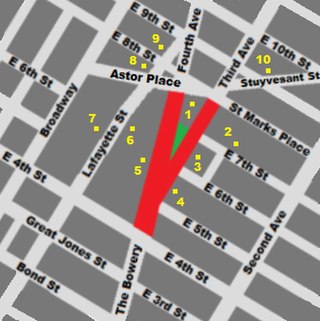
Peter Stuyvesant was a Dutch colonial officer who served as the last Dutch director-general of the colony of New Netherland from 1647 until it was ceded provisionally to the English in 1664, after which it was split into New York and New Jersey with lesser territory becoming parts of other colonies, and later, states. He was a major figure in the early history of New York City and his name has been given to various landmarks and points of interest throughout the city.

The East Village is a neighborhood on the East Side of Lower Manhattan in New York City. It is roughly defined as the area east of the Bowery and Third Avenue, between 14th Street on the north and Houston Street on the south. The East Village contains three subsections: Alphabet City, in reference to the single-letter-named avenues that are located to the east of First Avenue; Little Ukraine, near Second Avenue and 6th and 7th Streets; and the Bowery, located around the street of the same name.

The Bowery is a street and neighborhood in Lower Manhattan in New York City. The street runs from Chatham Square at Park Row, Worth Street, and Mott Street in the south to Cooper Square at 4th Street in the north. The eponymous neighborhood runs roughly from the Bowery east to Allen Street and First Avenue, and from Canal Street north to Cooper Square/East Fourth Street. The neighborhood roughly overlaps with Little Australia. To the south is Chinatown, to the east are the Lower East Side and the East Village, and to the west are Little Italy and NoHo. It has historically been considered a part of the Lower East Side of Manhattan.

8th Street is a street in the New York City borough of Manhattan that runs from Sixth Avenue to Third Avenue, and also from Avenue B to Avenue D; its addresses switch from West to East as it crosses Fifth Avenue. Between Third Avenue and Avenue A, it is named St. Mark's Place, after the nearby St. Mark's Church in-the-Bowery on 10th Street at Second Avenue.
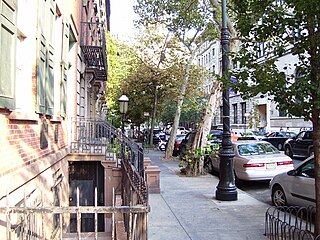

Bedford–Stuyvesant, colloquially known as Bed–Stuy, is a neighborhood in the northern section of the New York City borough of Brooklyn. Bedford–Stuyvesant is bordered by Flushing Avenue to the north, Classon Avenue to the west, Broadway to the east, and Atlantic Avenue to the south. The main shopping street, Fulton Street runs east–west the length of the neighborhood and intersects high-traffic north–south streets including Bedford Avenue, Nostrand Avenue, and Stuyvesant Avenue. Bedford–Stuyvesant contains four smaller neighborhoods: Bedford, Stuyvesant Heights, Ocean Hill, and Weeksville. Part of Clinton Hill was once considered part of Bedford–Stuyvesant.

The Bouwerie Lane Theatre is a former bank building which became an Off-Broadway theatre, located at 330 Bowery at Bond Street in Manhattan, New York City. It is located in the NoHo Historic District.
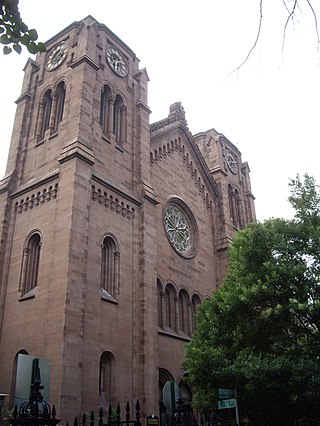
St. George's Episcopal Church is a historic church located at 209 East 16th Street at Rutherford Place, on Stuyvesant Square in Manhattan, New York City. Called "one of the first and most significant examples of Early Romanesque Revival church architecture in America", the church exterior was designed by Charles Otto Blesch and the interior by Leopold Eidlitz. It is one of the two sanctuaries of the Calvary-St. George's Parish.
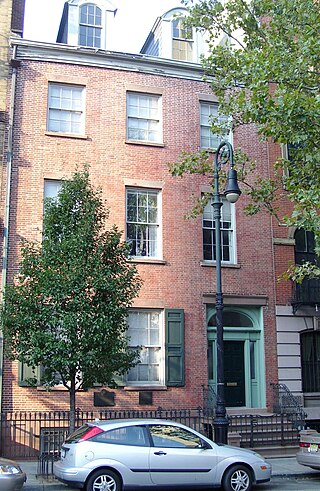
The Hamilton Fish House, also known as the Stuyvesant Fish House and Nicholas and Elizabeth Stuyvesant Fish House, is where Hamilton Fish (1808–93), later Governor and Senator of New York, was born and resided from 1808 to 1838. It is at 21 Stuyvesant Street, a diagonal street within the Manhattan street grid, between 9th and 10th Streets in the East Village neighborhood of New York City. It is owned by Cooper Union and used as a residence for the college's president.

St. Mark's Historic District is a historic district located in the East Village neighborhood of Manhattan, New York City. The district was designated a city landmark by the New York City Landmarks Preservation Commission in 1969, and it was extended in 1984 to include two more buildings on East 10th Street. It was listed on the National Register of Historic Places in 1974 and was expanded in 1985. The boundaries of the NRHP district and its expansion are now coterminous with those of the LPC.

The Church of St. Luke and St. Matthew is a historic Episcopal church at 520 Clinton Avenue between Fulton Street and Atlantic Avenue in the Clinton Hill neighborhood of Brooklyn, New York City. This congregation was founded as St. Luke's Protestant Episcopal Church in 1842 following the failure of Trinity Church, which had been consecrated in the same building on June 1, 1835, by Bishop Onderdonk of the Diocese of Long Island. The founding of a church in this location resulted from the expansion of Brooklyn beyond initial European settlement in Brooklyn Heights. The building was constructed on a property consisting of eight city lots donated by George W. Pine.
Nicholas Bayard was a government official and slave trader in colonial New York. Bayard served as the mayor of New York City from 1685 to 1686. He is historically most notable for being Peter Stuyvesant's nephew and for being a prominent member of the Bayard family, which remained prominent in New York City history into the 20th century.

Peter Gerard Stuyvesant was an American landowner, philanthropist and descendant of Peter Stuyvesant who was prominent in New York society in the 1600s.

110 East 42nd Street, also known as the Bowery Savings Bank Building, is an 18-story office building in Midtown Manhattan, New York City. The structure was designed in the Italian Romanesque Revival style by York and Sawyer, with William Louis Ayres as the partner in charge. It is on the south side of 42nd Street, across from Grand Central Terminal to the north and between the Pershing Square Building to the west and the Chanin Building to the east. 110 East 42nd Street is named for the Bowery Savings Bank, which had erected the building as a new branch structure to supplement its original building at 130 Bowery. The building was erected within "Terminal City", a collection of buildings above the underground tracks surrounding Grand Central, and makes use of real-estate air rights above the tracks. The building is directly above the New York City Subway's Grand Central–42nd Street station.
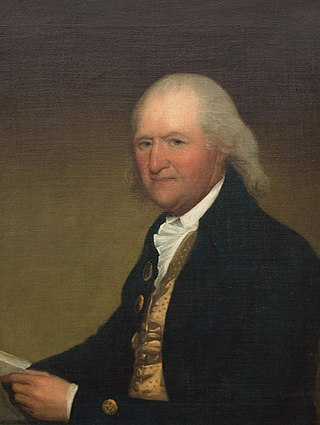
Petrus "Peter" Stuyvesant was a New York landowner and merchant who was a great-grandson of his namesake, Peter Stuyvesant, the last Dutch Director-General of New Amsterdam.
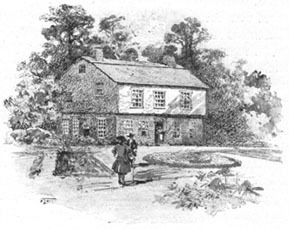
Stuyvesant Farm, also known as the Great Bowery, was the estate of Peter Stuyvesant, the last Dutch director-general of the colony of New Netherland, as well as his predecessors and later his familial descendants. The land was at first designated Bowery No. 1, the largest and northernmost of six initial estates of the Dutch West India Company north of New Amsterdam, used as the official residence and economic support for Willem Verhulst and all subsequent directors of the colony.














